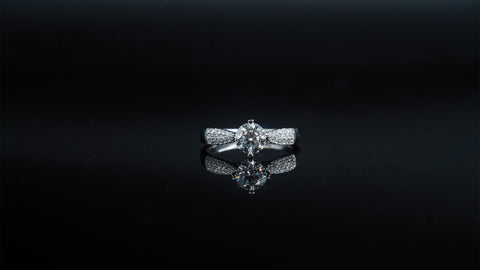Moissanite is a popular, eco-friendly and conflict-free alternative to diamonds. It is affordable and has a brilliant sparkle, making it a great choice for engagement rings. But can it be mistaken for a fake diamond or deceive diamond testers? Let's find out.

Ever since scientist Henry Moissan discovered moissanite in a meteor crater, experts have been able to replicate this exquisite gemstone in a lab and offer it to the world as a socially-responsible and brilliantly beautiful alternative to diamonds. As more people discover moissanite, they often wonder if there's a catch to its affordability and ethical sourcing. However, the truth is that moissanite is not too good to be true - it's simply an exceptional gemstone. With a hardness rating of 9.25-9.5, moissanite is nearly as hard as a diamond, which has a rating of 10. This means that moissanite is incredibly durable and can last just as long as a diamond while maintaining its clarity, fire, and brilliance for a lifetime. Due to its striking similarity to a diamond, moissanite is sometimes used as a diamond alternative in engagement rings. It's extremely difficult to distinguish between the two, even when placed side by side. While your friends and family may not notice a difference, how can you tell them apart?
How to tell Moissanite from Diamond
When a same-sized moissanite and diamond are compared side by side, it's nearly impossible to tell the difference with the naked eye. A high-quality moissanite and diamond are almost indistinguishable in appearance, with the main visible difference being moissanite's greater brilliance. Compared to a diamond, moissanite exhibits more colorful fire and is more sparkly, thanks to its higher refractive index and double refraction property. In simple terms, when a single beam of light enters the crown of a doubly refractive gemstone like moissanite, two beams of light exit, whereas a singly refractive gemstone like a diamond only allows one beam of light to enter and exit unbroken. This property of moissanite accounts for its higher dispersion of light and its more colorful display of sparkles, also known as fire. This heightened brilliance can create a "disco ball" effect as the light reflects out of the stone in rainbow flashes. While it can be difficult to detect this difference in person, it becomes more noticeable in larger stones as more light is reflected, and more colors are displayed. However, this difference is unlikely to be observed by your friends or family unless they know what to look for.

Can Moissanite Pass a Tester?
Moissanite stands out from other gemstones and faux diamonds in that it's an efficient conductor of heat. This makes moissanite indistinguishable from a diamond when using a diamond tester that detects thermal conductivity. Basic diamond testers only check for thermal conductivity, so while they can differentiate diamonds and moissanite from other stones, they often fail to detect the slight difference in conductivity between moissanite and diamonds. Basic diamond testers are useful tools for jewelers and gemologists, but their readings can't always be relied upon. It's worth noting that lab-grown moissanite has only been produced since the 1990s. Therefore, if a diamond tester indicates that a diamond is present in a stone from an earlier era, it's almost certainly an authentic diamond.
So, How Can You Test Moissanite?
To determine whether your gemstone is a moissanite or diamond, you will require a different type of tester. Specialized moissanite testers were created since moissanite has a slightly higher electrical conductivity. This method accurately distinguishes between moissanite and diamond, as diamonds are not electrically conductive. Today in the market, there are diamond testers that are often multi-testers, which means they can detect both thermal and electrical conductivity of a gemstone in a single test.
If you're uncertain about the authenticity of your diamond or wish to have your gemstone tested, there are no straightforward or trustworthy at-home methods that can provide reliable results. Our recommendation is to have your stone inspected by a trained jeweller or analysed by a gemological laboratory.
Conclusion:
In summary, moissanite can pass a diamond tester since it exhibits thermal conductivity, which is the primary factor that basic diamond testers use to distinguish diamonds from other stones. However, specialised moissanite testers were developed that can accurately differentiate between moissanite and diamond based on their slight differences in electrical conductivity. As for whether moissanite can be passed off as a diamond, the answer is yes for most people who are not familiar with gemstones. Nonetheless, we believe that moissanite is a unique and valuable gemstone that should be appreciated and cherished for its distinct qualities, rather than being viewed merely as a diamond alternative. Regardless of your preferences, we would be delighted to provide you with more information and assistance in creating your ideal ring.


